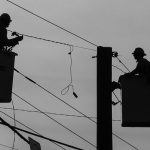How Composite Utility Poles are Better than Wooden Poles

Image courtesy of Michael Mol under Attribution 2.0 Generic License, resized to 700 x 391 pixels.
When it comes to grid-hardening activities, the deployment of composite utility poles is something that is worth considering. These types of poles are made from a combination of steel, concrete and fiberglass materials that are stronger and more durable than traditional materials, while at the same time being more flexible and lightweight. The result is a more durable type of pole that is more resistant to storm damage and long-term decay.
Advantages of Composite Utility Poles Vs. Traditional Wooden Poles
It goes without saying that more durable utility poles can have a positive impact on outage frequency. Traditional wood poles can easily break when caked with ice and snow, whereas composite poles are typically able to withstand the additional weight and remain upright. Recent data supports this statement: Hurricane Matthew, which occurred in Oct. 2016, destroyed 2,700 wooden poles in Florida, whereas the composite poles in the area were largely unscathed.
In addition to being stronger and more durable, composite utility poles tend to last longer than wooden poles because they are resistant to degradation and are not weakened by extreme temperature swings. This can have a positive impact on the financial bottom line. Each year, about 2% of wooden poles across the U.S. require replacement – roughly 2.5 million poles annually – much of which could be avoided with composite poles.
Finally, composite poles may be better for the environment than wooden poles, as the latter are often treated with a chemical coating which could potentially leach into drinking water and have a negative ecological impact.
From an emergency preparedness perspective, composite poles represent an intriguing tactic to help harden the infrastructure, which in turn could provide a reliability boost. Therefore, as your existing wooden poles break down, it would probably be fruitful to consider replacing them with composite utility poles, especially in challenging environments that have rugged terrain or are prone to periods of extreme weather.



